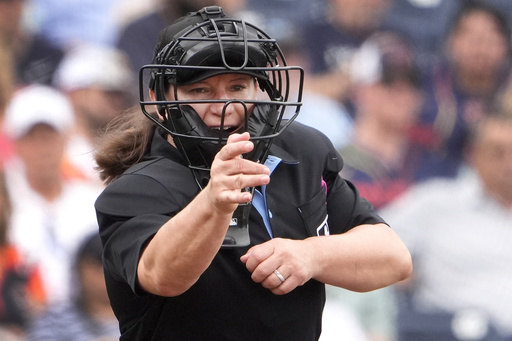
TAMPA, Florida — Major League Baseball (MLB) is set to trial a computerized ball and strike calling system during its spring training exhibition games, commencing this Thursday. This marks the culmination of four years of testing within the minor leagues.
Commissioner Rob Manfred has expressed strong support for the Automated Ball-Strike System (ABS), which might assist home plate umpires as early as 2026, although it will not replace their roles entirely. Beginning in 2024, MLB will emphasize a challenge system where the initial call is made by the human umpire. Data collected during the spring training testing could lead to adjustments in the system for Triple-A games later this season.
The Automated Ball-Strike System utilizes a network of cameras placed around the stadiums to monitor each pitch and determine whether it crosses the plate within the defined strike zone. In earlier trials, umpires would wear earpieces, receiving alerts indicating “ball” or “strike,” which they would communicate to players and spectators through traditional hand signals.
The challenge feature of the system adds an element of strategy. This spring training season, human umpires will make all calls, but each team will be granted the opportunity to contest up to two calls per game, without additional challenges in extra innings. Successful challenges will allow teams to retain their original number. Only the batter, pitcher, or catcher can initiate a challenge, signaling with a tap on their helmet or cap; no input from the dugout is permitted. Challenges must be submitted within two seconds of the call, and the corresponding pitch graphic along with the strike zone will be displayed on the scoreboard and broadcast feed. The estimated average time for the challenge process is around 17 seconds.
MLB has implemented the ABS in 13 spring training venues across 19 teams. The stadiums in Florida, under the Florida State League, include teams like the Detroit Tigers, Minnesota Twins, New York Mets, New York Yankees, Philadelphia Phillies, Pittsburgh Pirates, Toronto Blue Jays, and the shared facility for Miami Marlins and St. Louis Cardinals. In Arizona, sites are shared among teams like the Diamondbacks and Rockies, as well as various others including the White Sox and Dodgers, and the Mariners and Padres. Approximately 60% of the scheduled spring training games will utilize the ABS, although the number of games per team may vary widely; for instance, the Diamondbacks have 29 games planned with ABS, while the Cubs are set for just seven.
The technology behind the system includes a Hawk-Eye pose-tracking camera setup that evaluates pitches against the batter’s recorded height, which is taken without shoes prior to the season’s first game. The calibration process for each player takes under a minute. Most spring training venues feature eight cameras, while the combined Diamondbacks/Rockies venue will utilize twelve. It’s worth noting that while human umpires typically adopt an oval-shaped strike zone, the ABS defines the zone as a rectangle, as explicitly described in the official rules. Reaching a universal agreement on the definition of a computer-generated strike zone has proven challenging.
The journey of MLB’s experimentation with ABS began in the independent Atlantic League back in 2019. A challenge system was introduced in 2021 at eight of the nine ballparks in the Florida State League, followed by a trial in five Triple-A venues in 2022. The system evolved further in Triple-A stadiums throughout 2023, alternating between robotic calls and the human challenge method. The transition to a fully operational challenge system occurred late last June.
Last season, teams in Triple-A reported an overall challenge success rate of 51%, with the defensive teams winning 54% of their challenges and offensive teams winning 48%. With the system in place limiting teams to two challenges, an average of 3.9 challenges occurred per game, of which 2.2 were initiated by the offense. Meanwhile, major league video reviews saw a success rate of 53.7%, with the Boston Red Sox topping the leaderboard at 67.9%. The frequency of first-pitch challenges was low at just 1.6%, but with various counts, the likelihood increased substantially, showing a tendency for more late-game challenges.
Throughout the years, adjustments to the shape of the ABS strike zone have been made. Originally set at a width of 19 inches in 2022, the zone was later narrowed to 17 inches to conform with the width of home plate, resulting in a notable increase in walks and minor alterations in strikeout rates. In terms of height, the upper limit of the strike zone began at 51% of the batter’s height but was raised to 53.5% in 2024, addressing pitchers’ concerns. Notably, the bottom of the strike zone has remained at 27% since 2022. Notably, the batter’s position is not factored into these calculations. The ABS determines a ball or strike based on the mid-point of the plate, diverging from the manual rule book that indicates the strike zone as a cubic area. With the full implementation of ABS, strikeout rates climbed by 0.5%, and walk rates increased by 1%.
Concerns have emerged regarding how the ABS’s visible strike zone will affect broadcasts, as it could lead to disruptions in gameplay due to fans urging players to challenge calls. Consequently, MLB intends to explore various broadcasting formats, including displaying the strike zone while masking the ball, or just showing parts of the zone.
Players will have access to iPads in the dugout featuring an application named ProTABS, allowing them to evaluate pitches against their personalized strike zones. The data will refresh following each plate appearance, and players can provide feedback to MLB about specific pitches or the overall operation of the system.

